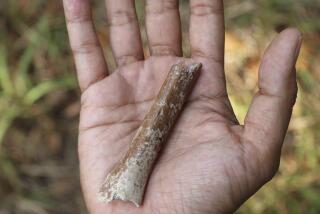Discovery of 47 teeth in Chinese cave changes picture of human migration out of Africa
- Share via
Forty-seven smooth teeth dug out of a cave in southern China reveal that Homo sapiens may have arrived there 80,000 years ago — long before humans were able to leave their mark on northern China or Europe.
The findings, published this week in the journal Nature, may compel researchers to reconsider their theories about human migrations out of Africa. In particular, the discovery may be a sign that Neanderthals posed a much greater barrier to Europe than archaeologists previously gave them credit for.
“It’s a game changer,” said Michael Petraglia, a Paleolithic archaeologist at Oxford University who was not involved in the work. The new cache of teeth “completely revolutionizes what we know about ‘out of Africa’ movements.”
See the most-read stories in Science this hour >>
Scientists believe Homo sapiens first emerged in East Africa between 190,000 and 160,000 years ago, then spread into the eastern Mediterranean around 100,000 to 60,000 years ago, according to Robin Dennell of the University of Exeter, who was not involved in the paper.
Analysis of DNA and examinations of stone tools suggest modern humans began trekking eastward into Asia around 60,000 years ago, followed by successful inroads westward into Europe about 40,000 years ago.
Paleoanthropologists have looked to caves in southern China for clues to fill in the story. These caves are full of fossils, but it has been difficult to pin down the ages of the specimens gathered, or even to tell which hominin species the fossils belong to.
The newly discovered teeth from Fuyan Cave are different. The limestone cave, in Hunan province, has an ideal mix of features that allowed scientists to pin down the fossils’ age.
In an acidic environment like Fuyan Cave, teeth are often the best-preserved human remains. Enamel, which covers a tooth’s outer surface, is the hardest tissue in the human body; dentin, which makes up most of the tooth, has a little more give but is still harder than bone.
For such fossils, understanding how deeply they were buried is vital, because each layer of rock represents a different epoch in time. The deeper the objects were found, the older they are. If those layers are scrambled in any way, it becomes very difficult for excavators to tell the true age of those fossils.
Luckily, in Fuyan Cave, water had deposited a layer of calcite flowstone over the sandy clay that held the human teeth, sealing them in and preventing them from being disturbed. Over the flowstone grew a mound of mineral deposits called a stalagmite. Radiometric dating revealed those minerals were around 80,100 years old — which means all the material below it, teeth included, must be older.
Beneath the flowstone, the scientists also found mammalian fossils from 38 species, including Stegodon orientalis (a relative of mammoths and elephants) and Ailuropoda baconi (an ancestor of the giant panda). These extinct large mammals lived during a period known as the Upper Pleistocene, about 125,000 to 10,000 years ago.
Together, the stalagmite formations and the fossils allowed researchers to bracket the ages of the human teeth — their owners must have lived sometime between 80,000 and 120,000 years ago.
These teeth, which included canine teeth and molars, look remarkably like those belonging to contemporary humans, not the larger, lumpier teeth of earlier hominin species, such as Homo erectus. This confirmed for the researchers that the teeth must have come from Homo sapiens that arose in Africa, rather than from a different hominin lineage.
“The Fuyan teeth indicate that modern humans were present in southern China 30,000 to 60,000 years earlier than in the eastern Mediterranean and Europe,” Dennell wrote in a commentary that accompanied the study.
That’s quite a gap. It could be a sign that our Neanderthal relatives blocked Homo sapiens’ initial attempts to break into Europe. Neanderthals had the advantage of being adapted to the cold, harsh European climate long before Homo sapiens, a species more suited to the sunny savanna, arrived on the scene, Petraglia pointed out. That would have made these paleo-pioneers ill-equipped to compete against their hominin cousins.
Previously, many scientists believed that humans’ inroads into Europe fairly quickly led to the Neanderthals’ demise.
“I really think it’s opening a new period of understanding and more creative thinking about the other possibilities of long-established models,” said paleoanthropologist María Martinón-Torres of University College London, who co-led the study with Wu Liu and Xiu-jie Wu of the Chinese Academy of Sciences.
There could be other explanations for Homo sapiens’ delay in getting to Europe, others said.
“The predominantly colder winter conditions of the enormous landmass between Europe and northern China may better explain the earlier colonization of southern zones,” Dennell wrote.
Either way, there are many new questions about how this migration into southern China relates to the human population today, Martinón-Torres said. Did these humans die out before being replaced with a later migration? Did they somehow mix with other Homo sapiens from Africa and later spread to other continents?
“We really have a lot of new questions about the origin of current populations,” she said. “I think it’s an exciting period.”
Follow @aminawrite for more science news.
MORE SCIENCE NEWS:
Cheers! For those managing diabetes, wine can help, study says
Pebbles on Mars point to an ancient river in Gale Crater, study finds
Your stressful job may kill you -- especially if you’re a woman, study says







